Land Tenure, Loans, and Farmers’ Cropland Conservation Behavior: Evidence from Rural Northwest China
Abstract
1. Introduction
2. Theoretical Analysis and Research Hypotheses
3. Material and Methods
3.1. Econometric Model
3.2. Data Collection
3.3. Specification of Independent Variables
4. Results
4.1. Benchmark Results
The Impact of Land Tenure Stability on Farmers’ CCB Adoption
4.2. Robustness Check
4.3. Endogeneity Problem
4.4. Mechanism Analysis
4.5. Additional Analysis
4.5.1. Land Tenure Stability and Risk Aversion on Farmers’ CCB Adoption
4.5.2. Land Tenure Stability and Time Preferences on Farmers’ CCB Adoption
4.5.3. Land Tenure Stability and Farmers’ CCB Adoption: Farm Scale Differences
4.5.4. Land Tenure Stability and Farmers’ CCB Adoption: Technical Training
5. Conclusions
Author Contributions
Funding
Institutional Review Board Statement
Data Availability Statement
Conflicts of Interest
| 1 | “White pollution” refers to the environmental degradation caused by the accumulation of waste plastic products. This term particularly highlights the issue of plastic pollutants, such as agricultural mulch films made from polymers including polystyrene, polypropylene, and polyvinyl chloride. The environmental challenge posed by these materials stems from their resistance to degradation. After their use, these plastics are frequently discarded, contributing to the growing problem of solid waste pollution. |
| 2 | Source: China Rural Statistical Yearbook in 2023. |
| 3 | Property right plays a role in stabilizing the main body practical expectation through the main body possess, use, benefit and punish rights (Barzel, 1997). |
| 4 | The data comes from the Ministry of Agriculture and Rural Affairs of the People’s Republic of China, “the Bulletin of 2019 National Cultivated Land Quality Grades”. http://www.moa.gov.cn/xw/zwdt/202005/t20200512_6343750.htm, accessed on 2 February 2024. |
| 5 | The data comes from the Ministry of Agriculture and Rural Affairs of the People’s Republic of China, “the Bulletin of 2019 National Cultivated Land Quality Grades”. |
| 6 | The data comes from Agriculture and Rural Department of Xinjiang Uygur Autonomous Region, “Further Improvement of Moderate Scale Management Level of Xinjiang Agriculture”. |
| 7 | The data comes from the Announcement of National Bureau of Statistics on Cotton Production in 2019. http://www.stats.gov.cn/tjsj/zxfb/201912/t20191217_1718007.html, accessed on 2 February 2024. |
| 8 | The source of the data for making the map is “China Rural Statistical Yearbook” in 2020. |
| 9 | The source of the data for making the map is “Xinjiang Provincial Statistical Yearbook” in 2020. |
Appendix A
| (1) | (2) | (3) | (4) | |
|---|---|---|---|---|
| Adoption Time of CCB | Adoption Time of CCB | CCB Adoption | CCB Adoption Rate | |
| Land tenure | 0.166 ** | 0.201 *** | ||
| (0.065) | (0.073) | |||
| Lease type | 0.062 *** | 7.083 *** | ||
| (0.024) | (2.300) | |||
| Age | −0.078 ** | −0.003 | −0.338 | |
| (0.031) | (0.003) | (0.258) | ||
| Gender | 0.775 | -0.011 | -0.928 | |
| (0.851) | (0.074) | (7.294) | ||
| Education | −0.226 * | −0.003 | −1.058 | |
| (0.130) | (0.008) | (0.816) | ||
| Cotton planting experience | 0.141 *** | −0.001 | −0.208 | |
| (0.045) | (0.003) | (0.247) | ||
| Household total numbers | −0.191 | 0.006 | −0.409 | |
| (0.153) | (0.017) | (1.478) | ||
| Technical subsidy | −1.019 | 0.190 *** | 9.593 ** | |
| (0.683) | (0.042) | (4.381) | ||
| Corps farmers | 1.663 ** | −0.059 | 1.928 | |
| (0.840) | (0.057) | (5.743) | ||
| Cotton fertility over the years | -0.087 | -0.034 | -2.195 | |
| (0.457) | (0.032) | (3.094) | ||
| Constant | 3.232 *** | 6.821 ** | 0.852 *** | 79.274 *** |
| (0.455) | (2.814) | (0.213) | (20.938) | |
| Observation | 335 | 335 | 349 | 338 |
| R2 | 0.017 | 0.085 | 0.080 | 0.053 |
| (1) | (2) | (3) | |
|---|---|---|---|
| First Stage | CCB Adoption | CCB Adoption Rate | |
| Land tenure | 0.027 ** | 3.533 *** | |
| (0.012) | (1.290) | ||
| IV | 0.999 *** | ||
| (0.135) | |||
| Constant | 0.877 *** | 81.676 *** | |
| (0.206) | (19.939) | ||
| Observation | 349 | 349 | 338 |
| R2 | 0.103 | 0.039 |
References
- Steinmetz, Z.; Wollmann, C.; Schaefer, M.; Buchmann, C.; David, J.; Tröger, J.; Schaumann, G.E. Plastic mulching in agriculture. Trading short-term agronomic benefits for long-term soil degradation? Sci. Total Environ. 2016, 550, 690–705. [Google Scholar] [CrossRef] [PubMed]
- Li, C.; Sun, M.; Xu, X.; Zhang, L.; Guo, J.; Ye, Y. Environmental village regulations matter: Mulch film recycling in rural China. J. Clean. Prod. 2021, 299, 126796. [Google Scholar] [CrossRef]
- Yang, Q.; Zhu, Y.; Liu, L.; Wang, F. Land tenure stability and adoption intensity of sustainable agricultural practices in banana production in China. J. Clean. Prod. 2022, 338, 130553. [Google Scholar] [CrossRef]
- Xue, Y.; Guo, J.; Li, C.; Xu, X.; Sun, Z.; Xu, Z.; Zhang, L. Influencing factors of farmers’ cognition on agricultural mulch film pollution in rural China. Sci. Total Environ. 2021, 787, 147702. [Google Scholar] [CrossRef]
- Wang, J.; Liu, X.; Li, Y.; Powell, T.; Wang, X.; Wang, G.; Zhang, P. Microplastics as contaminants in the soil environment: A mini-review. Sci. Total Environ. 2019, 691, 848–857. [Google Scholar] [CrossRef]
- Hu, Q.; Li, X.; Gonçalves, J.M.; Shi, H.; Tian, T.; Chen, N. Effects of residual plastic-film mulch on field corn growth and productivity. Sci. Total Environ. 2020, 729, 138901. [Google Scholar] [CrossRef]
- Li, W.; Wufuer, R.; Duo, J.; Wang, S.; Luo, Y.; Zhang, D.; Pan, X. Micro plastics in agricultural soils: Extraction and characterization after different periods of polythene film mulching in an arid region. Sci. Total Environ. 2020, 749, 141420. [Google Scholar] [CrossRef]
- Serrano-Ruiz, H.; Martin-Closas, L.; Pelacho, A.M. Biodegradable plastic mulches: Impact on the agricultural biotic environment. Sci. Total Environ. 2021, 750, 141228. [Google Scholar] [CrossRef]
- Yang, W.; Qi, J.; Arif, M.; Liu, M.; Lu, Y. Impact of information acquisition on farmers’ willingness to recycle plastic mulch film residues in China. J. Clean. Prod. 2021, 297, 126656. [Google Scholar] [CrossRef]
- Luo, X.; Guo, Y.; Wang, R.; Wang, N.; Li, C.; Chu, X.; Chen, H. Carbon footprint of a winter wheat-summer maize cropping system under straw and plastic film mulching in the Loess Plateau of China. Sci. Total Environ. 2021, 794, 148590. [Google Scholar] [CrossRef] [PubMed]
- Gebremedhin, B.; Swinton, S.M. Investment in soil conservation in northern Ethiopia: The role of land tenure security and public programs. Agric. Econ. 2003, 29, 69–84. [Google Scholar] [CrossRef]
- Tschopp, M.; Ceddia, M.G.; Inguaggiato, C.; Bardsley, N.O.; Hernández, H. Understanding the adoption of sustainable silvopastoral practices in Northern Argentina: What is the role of land tenure? Land Use Policy 2020, 99, 105092. [Google Scholar] [CrossRef]
- Hu, L.X.; Zhang, X.H.; Zhou, Y.H. Farm size and fertilizer sustainable use: An empirical study in Jiangsu, China. J. Integr. Agric. 2019, 18, 2898–2909. [Google Scholar] [CrossRef]
- Wu, Y.; Xi, X.; Tang, X.; Luo, D.; Gu, B.; Lam, S.K.; Chen, D. Policy distortions, farm size, and the overuse of agricultural chemicals in China. Proc. Natl. Acad. Sci. USA 2018, 115, 7010–7015. [Google Scholar] [CrossRef] [PubMed]
- Shiferaw, B.; Kebede, T.; Kassie, M.; Fisher, M. Market imperfections, access to information and technology adoption in Uganda: Challenges of overcoming multiple constraints. Agric. Econ. 2015, 46, 475–488. [Google Scholar] [CrossRef]
- Hu, Y.; Li, B.; Zhang, Z.; Wang, J. Farm size and agricultural technology progress: Evidence from China. J. Rural Stud. 2022, 93, 417–429. [Google Scholar] [CrossRef]
- Xu, Z.; Zhang, J.; Lv, K. The scale of operation, term of land ownership and the adoption of inter-temporal agricultural technology: An example of “straw return to soil directly”. China Rural Econ. 2018, 3, 61–74. (In Chinese) [Google Scholar]
- Wu, H.; Li, J. Risk preference, interlinked credit and insurance contract and agricultural innovative technology adoption. J. Innov. Knowl. 2023, 8, 100282. [Google Scholar] [CrossRef]
- Renkow, M. Technology, production environment, and household income: Assessing the regional impacts of technological change. Agric. Econ. 1994, 10, 219–231. [Google Scholar] [CrossRef]
- Liebenehm, S.; Waibel, H. Simultaneous estimation of risk and time preferences among small-scale cattle farmers in West Africa. Am. J. Agric. Econ. 2014, 96, 1420–1438. [Google Scholar] [CrossRef]
- Myers, R.J. Intervention bias in agricultural policy. Agric. Econ. 1992, 7, 209–224. [Google Scholar] [CrossRef]
- Gonzaga, J.F.; Vilpoux, O.F.; Pereira, M.W.G. Factors influencing technological practices in the Brazilian agrarian reform. Land Use Policy 2019, 80, 150–162. [Google Scholar] [CrossRef]
- Xie, J.; Yang, G.; Wang, G.; Song, Y.; Yang, F. How do different rural-land-consolidation modes shape farmers’ ecological production behaviors? Land Use Policy 2021, 109, 105592. [Google Scholar] [CrossRef]
- Paltasingh, K.R. Land tenure security and adoption of modern rice technology in Odisha, Eastern India: Revisiting Besley’s hypothesis. Land Use Policy 2018, 78, 236–244. [Google Scholar] [CrossRef]
- Gao, Y.; Liu, B.; Yu, L.; Yang, H.; Yin, S. Social capital, land tenure and the adoption of green control techniques by family farms: Evidence from Shandong and Henan Provinces of China. Land Use Policy 2019, 89, 104250. [Google Scholar] [CrossRef]
- Chankrajang, T. Partial land rights and agricultural outcomes: Evidence from Thailand. Land Econ. 2015, 91, 126–148. [Google Scholar] [CrossRef]
- Soule, M.J.; Tegene, A.; Wiebe, K.D. Land tenure and the adoption of conservation practices. Am. J. Agric. Econ. 2000, 82, 993–1005. [Google Scholar] [CrossRef]
- Mushinge, A.; Mulenga, S. Legal pluralism and tenure security: Exploring the relationship between statutory and customary land tenure in Zambia. Int. J. Soc. Sci. Stud. 2016, 4, 7. [Google Scholar] [CrossRef][Green Version]
- Ho, H.A. Land tenure and economic development: Evidence from Vietnam. World Dev. 2021, 140, 105275. [Google Scholar] [CrossRef]
- Suchá, L.; Schlossarek, M.; Dušková, L.; Malan, N.; Šarapatka, B. Land tenure security and its implications for investments to urban agriculture in Soweto, South Africa. Land Use Policy 2020, 97, 104739. [Google Scholar] [CrossRef]
- Rao, F.; Spoor, M.; Ma, X.; Shi, X. Perceived land tenure security in rural Xinjiang, China: The role of official land documents and trust. China Econ. Rev. 2020, 60, 101038. [Google Scholar] [CrossRef]
- Li, C.; Sun, M.; Xu, X.; Zhang, L. Characteristics and influencing factors of mulch film use for pollution control in China: Microcosmic evidence from smallholder farmers. Resour. Conserv. Recycl. 2021, 164, 105222. [Google Scholar] [CrossRef]
- Demsetz, H. Toward a theory of property rights. Am. Econ. Rev. 1967, 57, 347–359. [Google Scholar]
- Barzel, Y. Economic Analysis of Property Rights, 2nd ed.; Cambridge University Press: Cambridge, UK, 1997; pp. 1–11. [Google Scholar]
- Wang, Q.; Zhang, X. Three rights separation: China’s proposed rural land rights reform and four types of local trials. Land Use Policy 2017, 63, 111–121. [Google Scholar] [CrossRef]
- Domeher, D.; Abdulai, R. Land registration, credit and agricultural investment in Africa. Agric. Financ. Rev. 2012, 72, 87–103. [Google Scholar] [CrossRef]
- Abdulai, A.; Owusu, V.; Goetz, R. Land tenure differences and investment in land improvement measures: Theoretical and empirical analyses. J. Dev. Econ. 2011, 96, 66–78. [Google Scholar] [CrossRef]
- Jacoby, H.G.; Li, G.; Rozelle, S. Hazards of expropriation: Tenure insecurity and investment in rural China. Am. Econ. Rev. 2002, 92, 1420–1447. [Google Scholar] [CrossRef]
- Deininger, K.; Ali, D.A.; Alemu, T. Impacts of land certification on tenure security, investment, and land market participation: Evidence from Ethiopia. Land Econ. 2011, 87, 312–334. [Google Scholar] [CrossRef]
- Piza, C.; de Moura, M.J.S.B. The effect of a land titling programme on households’ access to credit. J. Dev. Effect. 2016, 8, 129–155. [Google Scholar] [CrossRef]
- Fenton, A.; Paavola, J.; Tallontire, A. The role of microfinance in household livelihood adaptation in Satkhira District, Southwest Bangladesh. World Dev. 2017, 92, 192–202. [Google Scholar] [CrossRef]
- Melesse, M.B.; Bulte, E. Does land registration and certification boost farm productivity? Evidence from Ethiopia. Agric. Econ. 2015, 46, 757–768. [Google Scholar] [CrossRef]
- Abdul-Rahaman, A.; Abdulai, A. Do farmer groups impact on farm yield and efficiency of smallholder farmers? Evidence from rice farmers in northern Ghana. Food Policy 2018, 81, 95–105. [Google Scholar] [CrossRef]
- Besley, T. Property rights and investment incentives: Theory and evidence from Ghana. J. Political Econ. 1995, 103, 903–937. [Google Scholar] [CrossRef]
- Li, F.; Ren, J.; Wimmer, S.; Yin, C.; Li, Z.; Xu, C. Incentive mechanism for promoting farmers to plant green manure in China. J. Clean. Prod. 2020, 267, 122197. [Google Scholar] [CrossRef]
- Ma, X.; Heerink, N.; van Ierland, E.; van den Berg, M.; Shi, X. Land tenure security and land investments in Northwest China. China Agric. Econ. Rev. 2013, 5, 281–307. [Google Scholar] [CrossRef]
- Batz, F.J.; Peters, K.J.; Janssen, W. The influence of technology characteristics on the rate and speed of adoption. Agric. Econ. 1999, 21, 121–130. [Google Scholar] [CrossRef]
- Barham, B.L.; Chavas, J.P.; Fitz, D.; Salas, V.R.; Schechter, L. The roles of risk and ambiguity in technology adoption. J. Econ. Behav. Organ. 2014, 97, 204–218. [Google Scholar] [CrossRef]
- Mubanga, F.C.; Umar, B.B. Environmental discounting behaviour of smallholder farmers in Chibombo District, Central Zambia. Land Use Policy 2020, 95, 104551. [Google Scholar] [CrossRef]
- Mandal, S.; Misra, G.V.; Naqvi, S.M.A.; Kumar, N. Situational analysis of agricultural land leasing in Uttar Pradesh. Land Use Policy 2019, 88, 104106. [Google Scholar] [CrossRef]
- Duflo, E.; Kremer, M.; Robinson, J. Nudging farmers to use fertilizer: Theory and experimental evidence from Kenya. Am. Econ. Rev. 2011, 101, 2350–2390. [Google Scholar] [CrossRef]
- Schleich, J.; Gassmann, X.; Meissner, T.; Faure, C. A large-scale test of the effects of time discounting, risk aversion, loss aversion, and present bias on household adoption of energy-efficient technologies. Energy Econ. 2019, 80, 377–393. [Google Scholar] [CrossRef]
- Mao, H.; Zhou, L.; Ying, R.; Pan, D. Time Preferences and green agricultural technology adoption: Field evidence from rice farmers in China. Land Use Policy 2021, 109, 105627. [Google Scholar] [CrossRef]
- Harris, C.; Laibson, D. Instantaneous gratification. Q. J. Econ. 2013, 128, 205–248. [Google Scholar] [CrossRef]
- Abdellaoui, M.; Kemel, E.; Panin, A.; Vieider, F.M. Measuring time and risk preferences in an integrated framework. Games Econ. Behav. 2019, 115, 459–469. [Google Scholar] [CrossRef]
- Bewket, W. Soil and water conservation intervention with conventional technologies in northwestern highlands of Ethiopia: Acceptance and adoption by farmers. Land Use Policy 2007, 24, 404–416. [Google Scholar] [CrossRef]
- Khanna, M. Sequential adoption of site-specific technologies and its implications for nitrogen productivity: A double selectivity model. Am. J. Agric. Econ. 2001, 83, 35–51. [Google Scholar] [CrossRef]
- Yan, J.; Yang, Z.; Li, Z.; Li, X.; Xin, L.; Sun, L. Drivers of cropland abandonment in mountainous areas: A household decision model on farming scale in Southwest China. Land Use Policy 2016, 57, 459–469. [Google Scholar] [CrossRef]
- Shikuku, K.M. Information exchange links, knowledge exposure, and adoption of agricultural technologies in northern Uganda. World Dev. 2019, 115, 94–106. [Google Scholar] [CrossRef]
- Goyal, M.; Netessine, S. Strategic technology choice and capacity investment under demand uncertainty. Manag. Sci. 2007, 53, 192–207. [Google Scholar] [CrossRef]
- Adegbola, P.; Gardebroek, C. The effect of information sources on technology adoption and modification decisions. Agric. Econ. 2007, 37, 55–65. [Google Scholar] [CrossRef]
- Ren, G.; Zhu, X.; Heerink, N.; Feng, S. Rural household migration in China—The roles of actual and perceived tenure security. China Econ. Rev. 2020, 63, 101534. [Google Scholar] [CrossRef]
- Zhen, L.; Cao, S.; Cheng, S.; Xie, G.; Wei, Y.; Liu, X.; Li, F. Arable land requirements based on food consumption patterns: Case study in rural Guyuan District, Western China. Ecol. Econ. 2010, 69, 1443–1453. [Google Scholar] [CrossRef]
- Mi, Q.; Li, X.; Gao, J. How to improve the welfare of smallholders through agricultural production outsourcing: Evidence from cotton farmers in Xinjiang, Northwest China. J. Clean. Prod. 2020, 256, 120636. [Google Scholar] [CrossRef]
- Brick, K.; Visser, M. Risk preferences, technology adoption and insurance uptake: A framed experiment. J. Econ. Behav. Organ. 2015, 118, 383–396. [Google Scholar] [CrossRef]
- Marenya, P.; Smith, V.H.; Nkonya, E. Relative preferences for soil conservation incentives among smallholder farmers: Evidence from Malawi. Am. J. Agric. Econ. 2014, 96, 690–710. [Google Scholar] [CrossRef]
- Ismet, M.; Barkley, A.P.; Llewelyn, R.V. Government intervention and market integration in Indonesian rice markets. Agric. Econ. 1998, 19, 283–295. [Google Scholar] [CrossRef]
- Imbens, G. Instrumental variables: An econometrician’s perspective. Stat. Sci. 2014, 29, 323–358. [Google Scholar] [CrossRef]
- Fisman, R.; Svensson, J. Are corruption and taxation really harmful to growth? Firm level evidence. J. Dev. Econ. 2007, 83, 63–75. [Google Scholar] [CrossRef]
- Stock, J.H.; Wright, J.H.; Yogo, M. A survey of weak instruments and weak identification in generalized method of moments. J. Bus. Econ. Stat. 2002, 20, 518–529. [Google Scholar] [CrossRef]
- Sossou, S.; Mbaye, A.A. Impact of Land Security on Household’s Agricultural Productivity in Benin. Asian J. Agric. Ext. Econ. Sociol. 2018, 28, 1–13. [Google Scholar] [CrossRef]
- Xu, J.; Chen, J.; Zhao, S. The impact of free farmland transfer on the adoption of conservation tillage technology—Empirical evidence from rural China. Heliyon 2022, 8, e11578. [Google Scholar] [CrossRef] [PubMed]
- Zheng, L.; Li, L.; Zhao, Z.; Qian, W. Does land certification increase farmers’ use of organic fertilizer? evidence from China. J. Land Use Sci. 2023, 18, 39–54. [Google Scholar] [CrossRef]
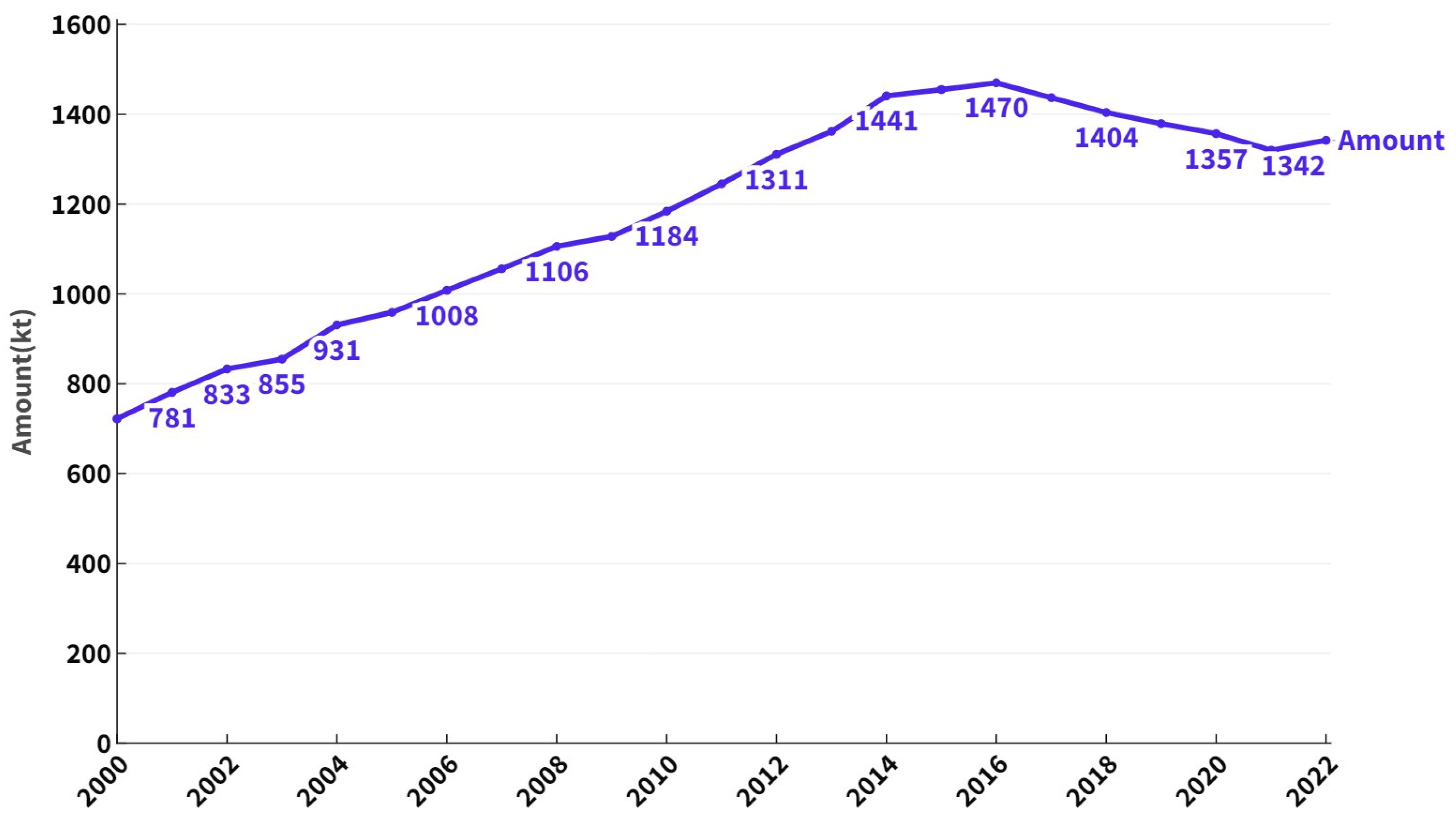
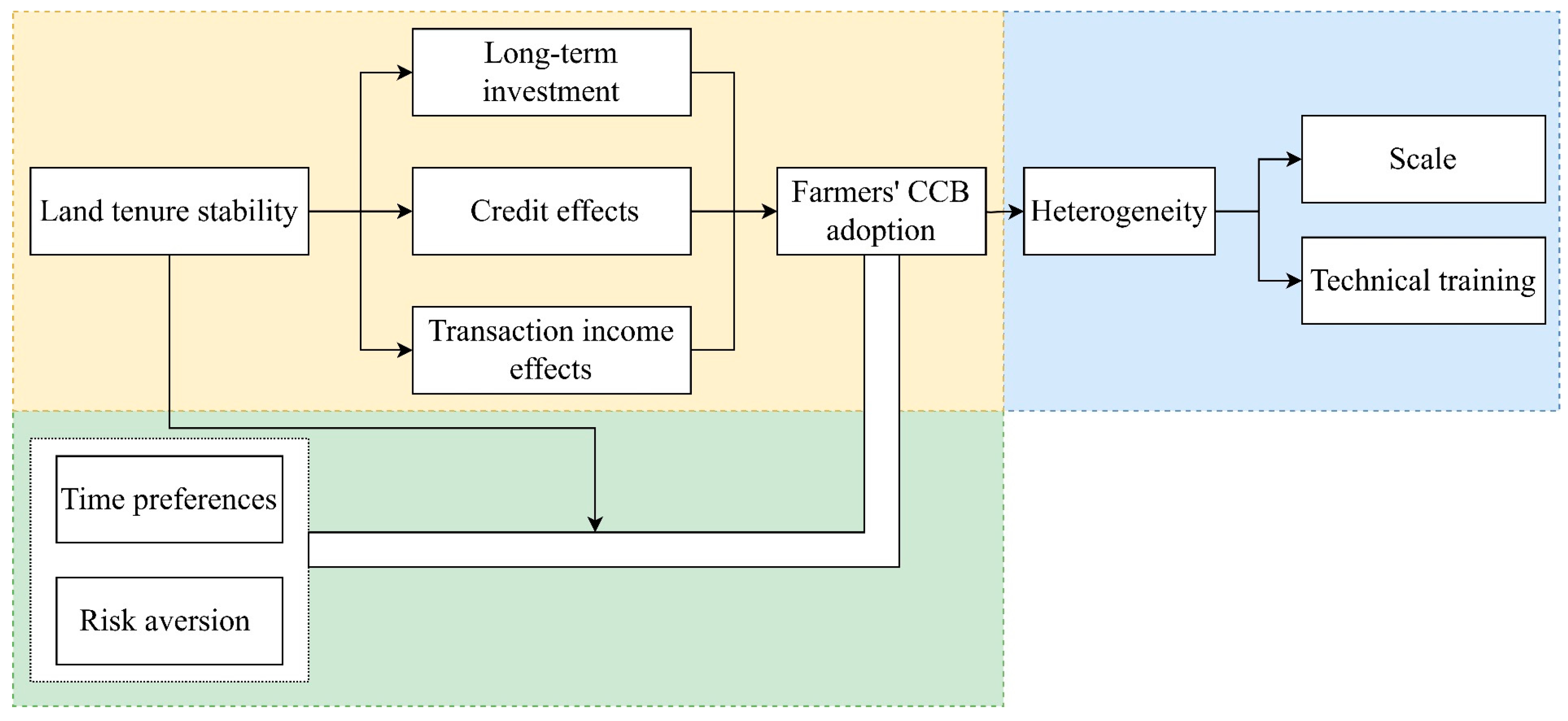
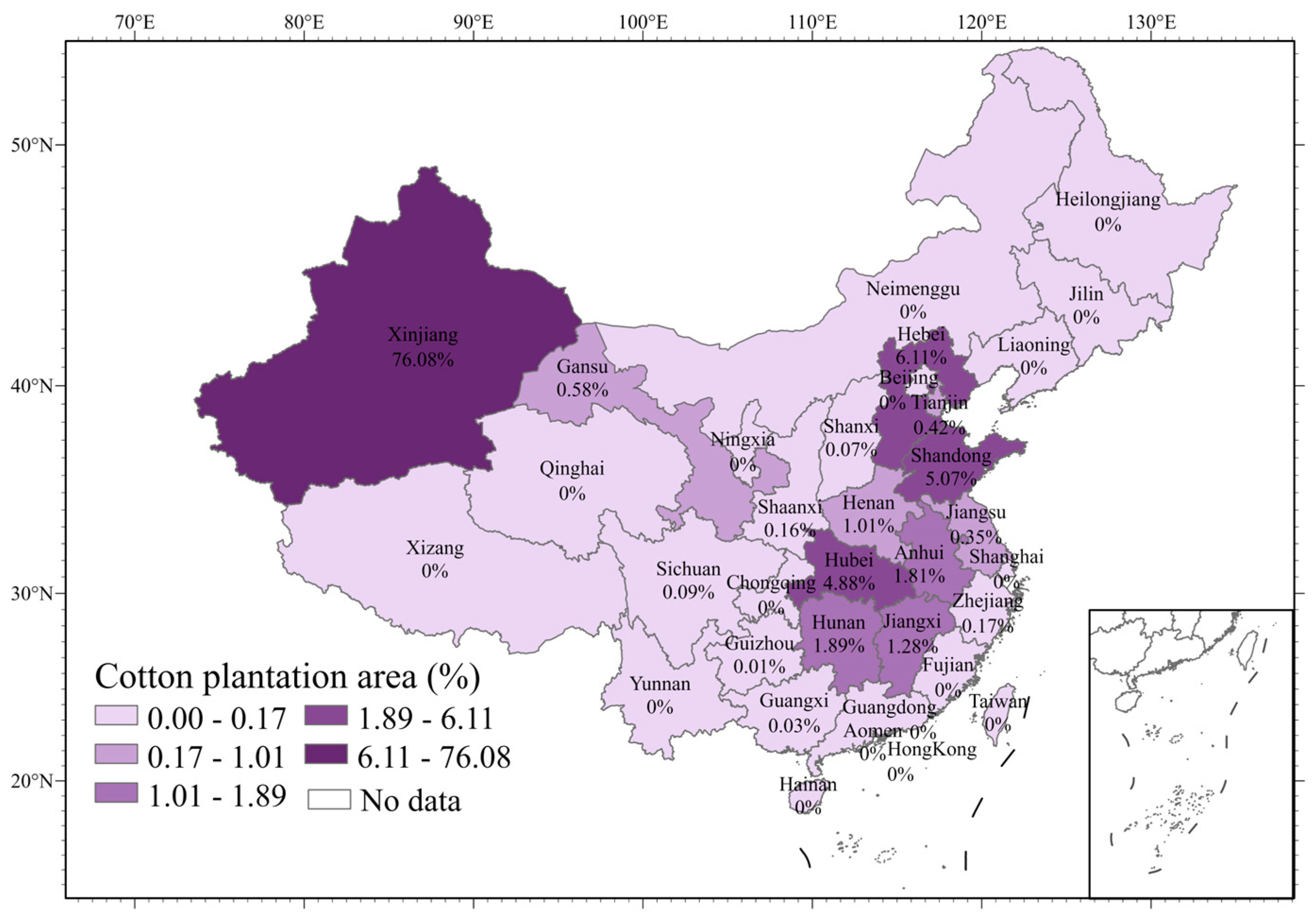
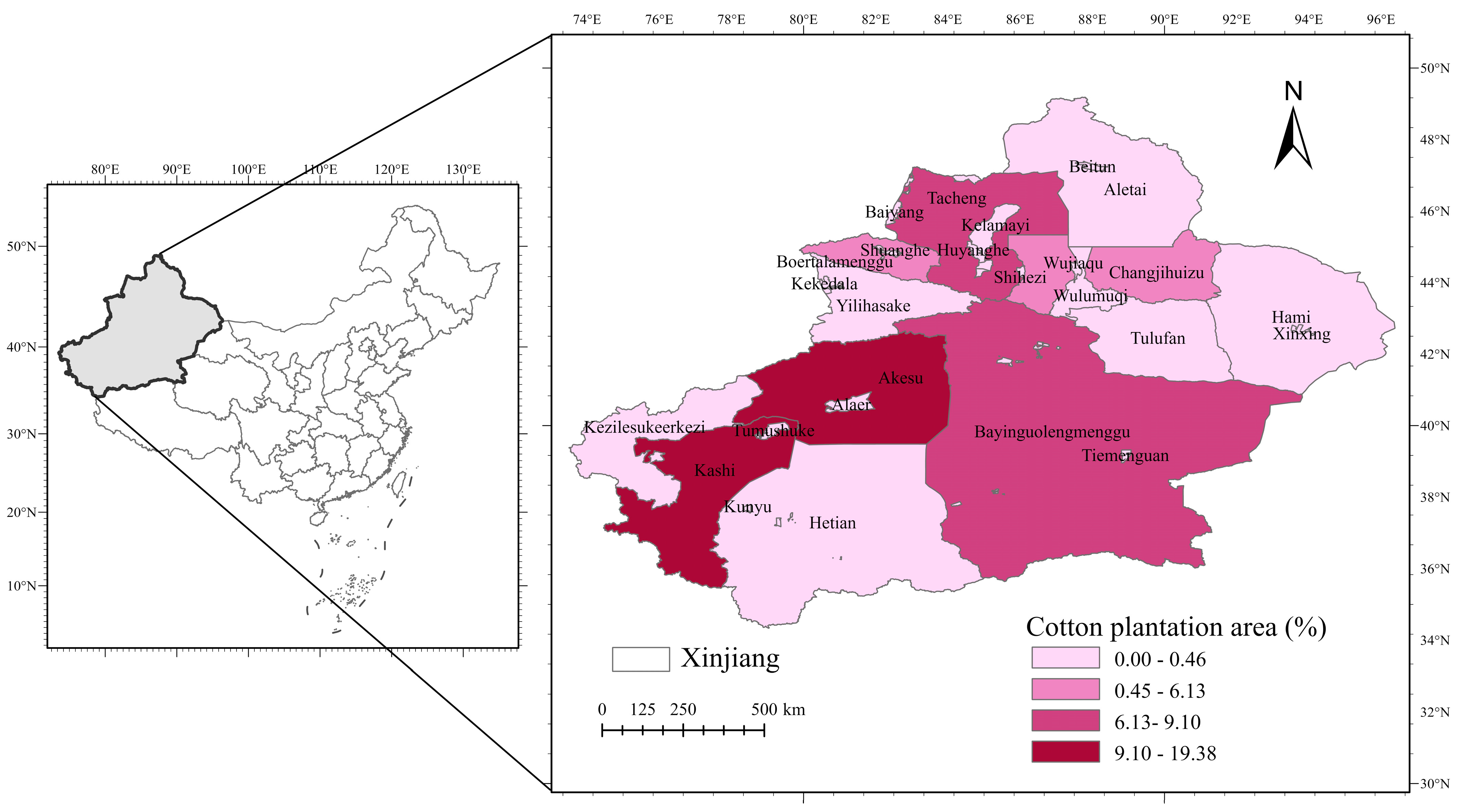
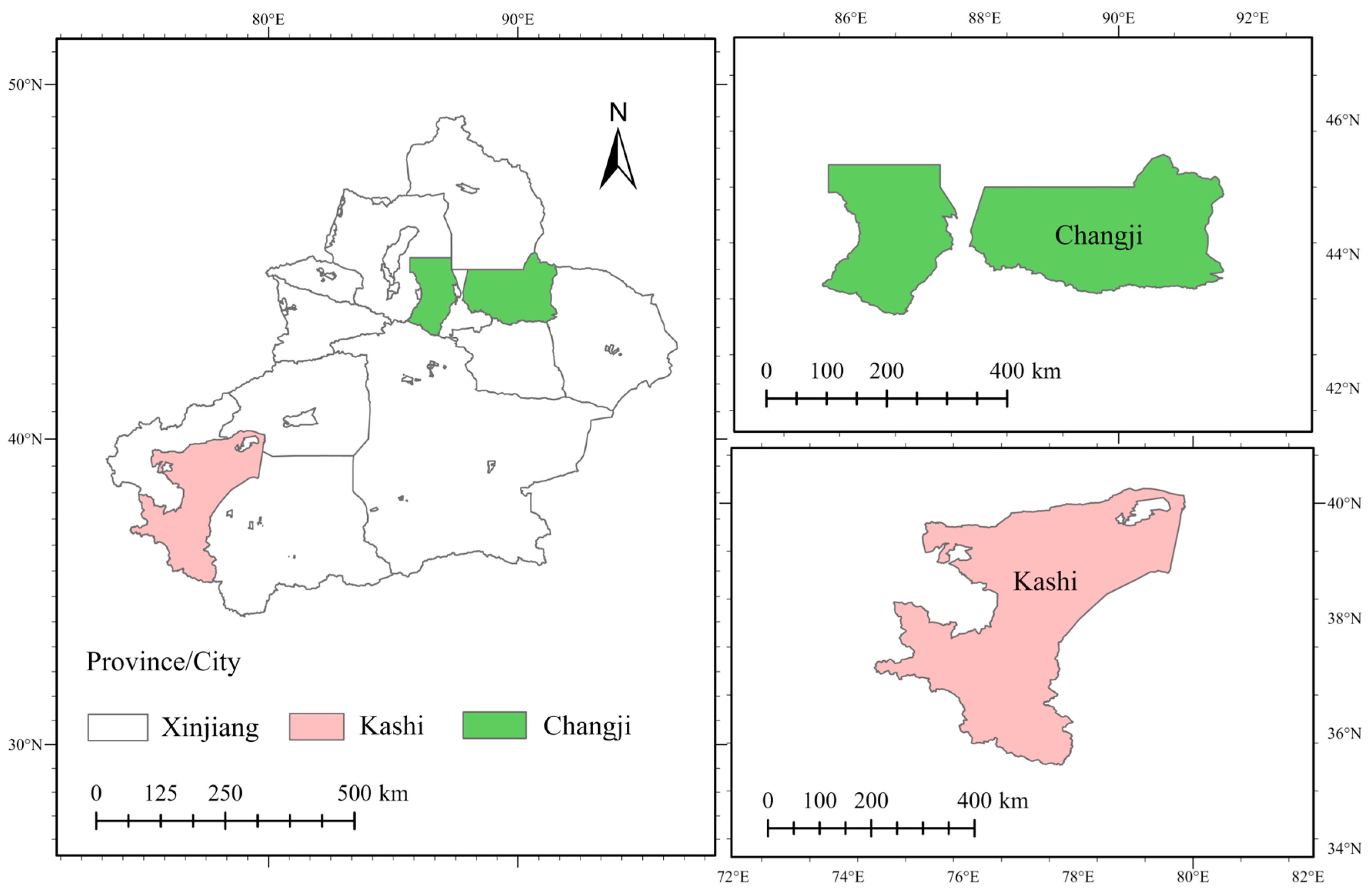
| Variable | Explanation | Mean | Std.dev | Min | Max |
|---|---|---|---|---|---|
| Explained variable | |||||
| CCB adoption | Whether farmers adopt CCB: Yes = 1; No = 0 | 0.762 | 0.426 | 0 | 1 |
| CCB adoption rate | Farmers’ adoption proportion of CCB (%) | 61.488 | 40.904 | 0 | 100 |
| Adoption time of CCB | Farmers’ cumulative adoption years of CCB (years) | 4.284 | 5.873 | 0 | 38 |
| Key explanatory variable | |||||
| Land tenure | Period for farmers to transfer cultivated land (years) | 6.407 | 4.575 | 0 | 30 |
| Lease type | No agreement = 0; oral = 1; written, but not completed by local government = 2; written and completed by the local government = 3 | 2.083 | 1.038 | 0 | 3 |
| Risk aversion | The degree of farmers’ risk aversion(σ) | 0.774 | 0.409 | 0.05 | 1.45 |
| Time preferences | Whether household head is far-sighted: Yes = 1; No = 0 | 0.095 | 0.293 | 0 | 1 |
| Technical training | Whether farmers participate in CCB training: Yes = 1; No = 0 | 0.397 | 0.490 | 0 | 1 |
| Farm scale | Actual cotton-planting area of farmers (hundred mu) | 4.477 | 14.480 | 0.032 | 160 |
| Control Variable | |||||
| Age | Age of household head (years) | 50.043 | 9.631 | 24 | 90 |
| Gender | Gender of household head: Male = 1; Female = 0 | 0.894 | 0.308 | 0 | 1 |
| Education | Education level of household head (years) | 7.977 | 2.794 | 0 | 16 |
| Cotton-planting experience | Cotton-planting years of household head (years) | 15.33 | 9.617 | 0 | 50 |
| Household total numbers | Total number of farmers’ households (person) | 4.527 | 1.629 | 1 | 16 |
| Technical subsidy | Whether there is plastic mulch film subsidy locally: Yes = 1; No = 0 | 0.338 | 0.474 | 0 | 1 |
| Corps farmers | Whether farmers are corps farmers: Yes = 1; No = 0 | 0.249 | 0.433 | 0 | 1 |
| Cotton fertility over the years | Soil fertility of farmers’ cotton fields: 1 = Poor; 2 = Medium; 3 = Good; 4 = Excellent | 2.309 | 0.759 | 1 | 4 |
| (1) | (2) | (3) | (4) | |
|---|---|---|---|---|
| CCB Adoption | CCB Adoption | CCB Adoption Rate | CCB Adoption Rate | |
| Land tenure | 0.019 *** | 0.021 *** | 1.835 *** | 1.961 *** |
| (0.005) | (0.005) | (0.508) | (0.530) | |
| Age | −0.003 | −0.325 | ||
| (0.003) | (0.251) | |||
| Gender | 0.028 | 3.222 | ||
| (0.076) | (7.444) | |||
| Education | −0.007 | −1.544 * | ||
| (0.008) | (0.802) | |||
| Cotton-planting experience | −0.000 | −0.174 | ||
| (0.003) | (0.241) | |||
| Household total numbers | 0.008 | −0.221 | ||
| (0.016) | (1.408) | |||
| Technical subsidy | 0.150 *** | 5.351 | ||
| (0.042) | (4.299) | |||
| Corps farmers | −0.089 | −1.054 | ||
| (0.056) | (5.699) | |||
| Cotton fertility over the years | −0.060 * | −4.875 | ||
| (0.031) | (2.992) | |||
| Constant | 0.639 *** | 0.900 *** | 49.871 *** | 88.178 *** |
| (0.044) | (0.203) | (4.031) | (19.480) | |
| Observation | 349 | 349 | 338 | 338 |
| R2 | 0.044 | 0.107 | 0.043 | 0.068 |
| Panel A CCB Adoption | ||||
|---|---|---|---|---|
| (1) | (2) | (3) | (4) | |
| CCB Adoption | CCB Adoption | Land Mortgage Loans | CCB Adoption | |
| Land tenure | 0.021 *** | 0.009 ** | 0.020 *** | |
| (0.005) | (0.005) | (0.006) | ||
| Land mortgage loans | 0.142 ** | 0.106 * | ||
| (0.061) | (0.060) | |||
| Control variables | Yes | Yes | Yes | Yes |
| Constant | 0.900 *** | 0.943 *** | 0.254 | 0.874 *** |
| (0.203) | (0.205) | (0.163) | (0.201) | |
| Observation | 349 | 349 | 349 | 349 |
| R2 | 0.107 | 0.069 | 0.080 | 0.113 |
| Panel B CCB Adoption Rate | ||||
| (1) | (2) | (3) | (4) | |
| CCB Adoption Rate | CCB Adoption Rate | Land Mortgage Loans | CCB Adoption Rate | |
| Land tenure | 1.961 *** | 0.009 ** | 1.860 *** | |
| (0.530) | (0.005) | (0.536) | ||
| Land mortgage loans | 14.654 ** | 11.368 * | ||
| (6.464) | (6.338) | |||
| Control variables | Yes | Yes | Yes | Yes |
| Constant | 88.178 *** | 91.679 *** | 0.254 | 85.018 *** |
| (19.480) | (19.852) | (0.163) | (19.363) | |
| Observation | 349 | 349 | 349 | 349 |
| R2 | 0.068 | 0.035 | 0.080 | 0.075 |
| (1) | (2) | (3) | (4) | |
|---|---|---|---|---|
| CCB Adoption | CCB Adoption | CCB Adoption Rate | CCB Adoption Rate | |
| Land tenure | 0.019 *** | 0.012 * | 1.877 *** | 0.968 |
| (0.005) | (0.006) | (0.544) | (0.622) | |
| Risk aversion | −0.116 ** | −0.270 *** | −3.628 | −24.839 *** |
| (0.056) | (0.098) | (5.662) | (9.125) | |
| Land tenure risk aversion | 0.025 ** | 3.510 *** | ||
| (0.011) | (1.093) | |||
| Control variables | Yes | Yes | Yes | Yes |
| Constant | 0.951 *** | 0.996 *** | 89.632 *** | 96.042 *** |
| (0.208) | (0.209) | (19.752) | (20.060) | |
| Observation | 349 | 349 | 338 | 338 |
| R2 | 0.118 | 0.129 | 0.069 | 0.093 |
| (1) | (2) | (3) | (4) | |
|---|---|---|---|---|
| CCB Adoption | CCB Adoption | CCB Adoption Rate | CCB Adoption Rate | |
| Land tenure | 0.017 *** | 0.013 ** | 1.622 *** | 1.420 *** |
| (0.005) | (0.005) | (0.525) | (0.547) | |
| Time preferences | −0.406 *** | −0.644 *** | −31.534 *** | −42.459 *** |
| (0.082) | (0.106) | (7.921) | (10.328) | |
| Land tenure time preferences | 0.062 *** | 2.858 | ||
| (0.012) | (1.806) | |||
| Control variables | Yes | Yes | Yes | Yes |
| Constant | 0.907 *** | 0.913 *** | 88.622 *** | 88.899 *** |
| (0.182) | (0.175) | (17.866) | (17.762) | |
| Observation | 349 | 349 | 338 | 338 |
| R2 | 0.178 | 0.205 | 0.116 | 0.122 |
| (1) | (2) | (3) | (4) | |
|---|---|---|---|---|
| CCB Adoption | CCB Adoption Rate | |||
| Large-Scale Farmers | Small-Scale Farmers | Large-Scale Farmers | Small-Scale Farmers | |
| Land tenure | 0.035 *** | 0.018 ** | 2.886 *** | 1.724 ** |
| (0.009) | (0.008) | (0.859) | (0.741) | |
| Control variables | Yes | Yes | Yes | Yes |
| Constant | 0.432 | 1.171 *** | 51.299 | 113.358 *** |
| (0.347) | (0.246) | (31.312) | (24.510) | |
| Observation | 154 | 195 | 150 | 188 |
| R2 | 0.244 | 0.120 | 0.179 | 0.091 |
| (1) | (2) | (3) | (4) | |
|---|---|---|---|---|
| CCB Adoption | CCB Adoption Rate | |||
| Participate in Technical Training | Not Participating in Technical Training | Participate in Technical Training | Not Participating in Technical Training | |
| Land tenure | 0.035 *** | 0.015 ** | 2.994 *** | 1.544 ** |
| (0.008) | (0.007) | (1.072) | (0.665) | |
| Control variables | Yes | Yes | Yes | Yes |
| Observation | 122 | 185 | 122 | 185 |
| R2 | 0.325 | 0.109 | 0.207 | 0.067 |
Disclaimer/Publisher’s Note: The statements, opinions and data contained in all publications are solely those of the individual author(s) and contributor(s) and not of MDPI and/or the editor(s). MDPI and/or the editor(s) disclaim responsibility for any injury to people or property resulting from any ideas, methods, instructions or products referred to in the content. |
© 2024 by the authors. Licensee MDPI, Basel, Switzerland. This article is an open access article distributed under the terms and conditions of the Creative Commons Attribution (CC BY) license (https://creativecommons.org/licenses/by/4.0/).
Share and Cite
Long, G.; Zhou, X.; Li, J. Land Tenure, Loans, and Farmers’ Cropland Conservation Behavior: Evidence from Rural Northwest China. Land 2024, 13, 413. https://doi.org/10.3390/land13040413
Long G, Zhou X, Li J. Land Tenure, Loans, and Farmers’ Cropland Conservation Behavior: Evidence from Rural Northwest China. Land. 2024; 13(4):413. https://doi.org/10.3390/land13040413
Chicago/Turabian StyleLong, Guoren, Xiaoyan Zhou, and Jun Li. 2024. "Land Tenure, Loans, and Farmers’ Cropland Conservation Behavior: Evidence from Rural Northwest China" Land 13, no. 4: 413. https://doi.org/10.3390/land13040413
APA StyleLong, G., Zhou, X., & Li, J. (2024). Land Tenure, Loans, and Farmers’ Cropland Conservation Behavior: Evidence from Rural Northwest China. Land, 13(4), 413. https://doi.org/10.3390/land13040413







